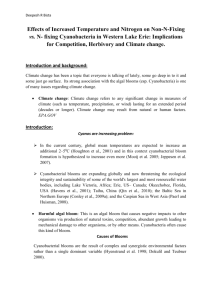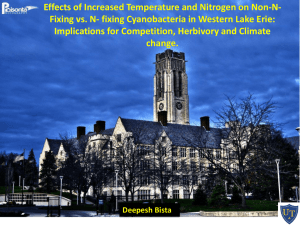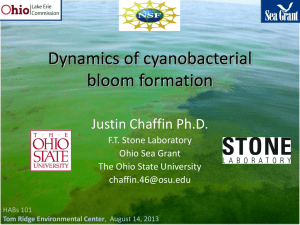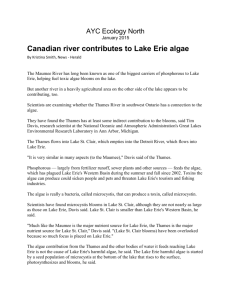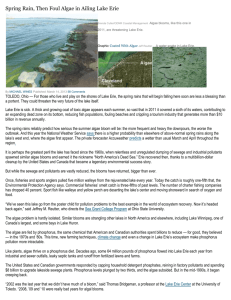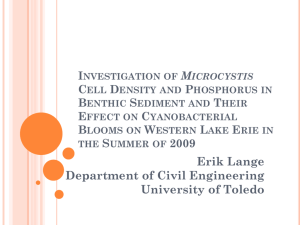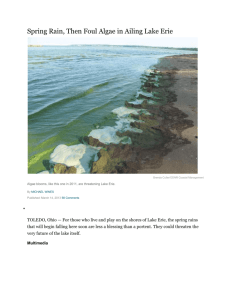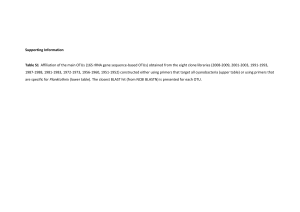Slides - University of Toledo
advertisement
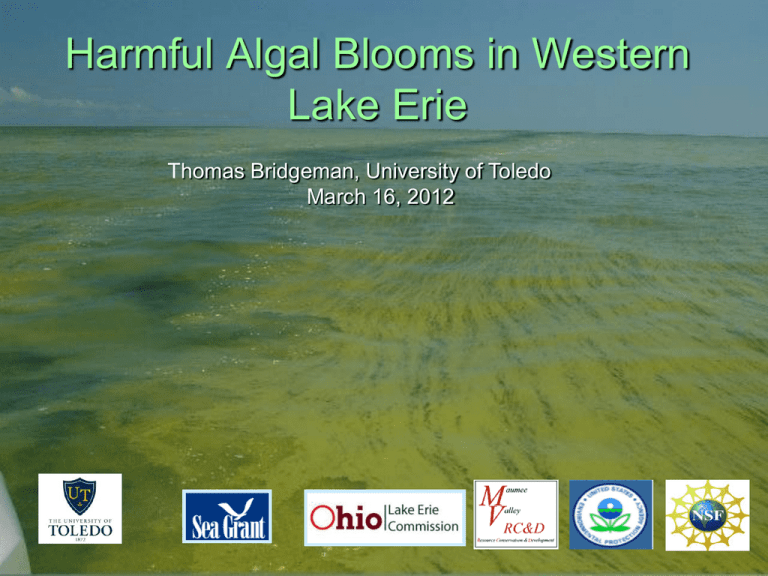
Harmful Algal Blooms in Western Lake Erie Thomas Bridgeman, University of Toledo March 16, 2012 Algae are tiny plant-like organisms that live in water There are hundreds of species of algae in Lake Erie. Most are beneficial. Major groups in Lake Erie Diatoms Greens Blue-greens (Cyanobacteria) Cyanobacteria in Lake Erie Anabaena Aphanizomenon Microcystis Factors leading to cyanobacteria blooms •Seasonal patterns -Late summer is cyanobacteria season. -Climate Change: What would be the effect of an extended summer? Factors leading to cyanobacteria blooms •Phosphorus concentration -High P concentrations result in dominance by cyanobacteria (Kalff 2001) Eutrophication of Lake Erie Eutrophication of Lake Erie • Between1920 and 1964 Lake Erie algae biomass increased nearly 6 fold. • Diatoms replaced by cyanobacteria. • Harmful algal blooms led to passage of the GLWQA 1964 1920 Davis 1964 Algae Recovery and recent return to eutrophic conditions Conroy & Culver 2005 Microcystis bloom August 2003 Toledo Water Intake OhioView Why should we care? Harmful Algal Blooms produce toxins •Microcystis produces microcystin •Fatal poisonings in Brazil 1988, 1996 •Pets poisoned in the USA •Rotten smell, fouled beaches – public perception of lake as polluted. •Contribute to central basin Dead Zone •Economic cost, additional $3K-$4K/day water treatment • Harmful to sport fish recruitment ($1B fishery) Field Methods (2002-2011) 6 sites sampled biweekly 112 um mesh plankton net Nutrients Maumee Bay West Sister Island Annual estimate of Microcystis 2009 2002 Microcystis in Lake Erie • • The Microcystis-Anabaena bloom of 2009 was the largest in recent years in our sampling region …until 2011 2011 Bloom of 2011 Large Bloom in the Western Basin, followed by a large bloom in the Central Basin or Lake Erie. •Was it the same stuff just transported to the east? •Or was it new growth, fertilized by different sources? August 11 2011 MODIS images October 7 2011 What accounts for the large interannual variation in Microcystis blooms? -What is the effect of Maumee River P loading? The best predictor of Microcystis annual crop is the cumulative TP load from the Maumee River from January to August. What accounts for the large interannual variation in Microcystis blooms? -What is the effect of Maumee River P loading? Time series analysis, 2002-2009 Correlation Factor Summer Microcystis is somewhat correlated to Total P loading 4-6 months earlier Year What accounts for the large interannual variation in Microcystis blooms? -What is the effect of Maumee River P loading? Phosphorus load vs. Microcystis time series analysis 2002-2009 Correlation Factor Summer Microcystis is highly correlated to Dissolved Reactive P loading 4-8 weeks earlier Year Lyngbya wollei, a new nuisance cyanobacterium in Lake Erie
